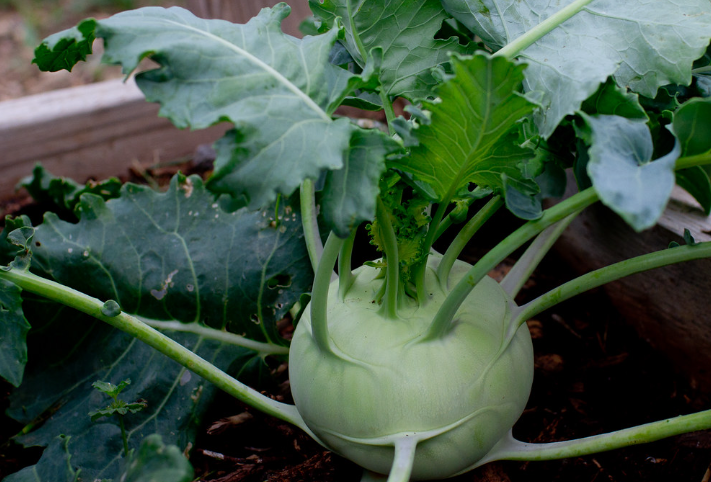Kohlrabi Splitting: Why Does It Happen and What Can You Do?

Kohlrabi is one of those vegetables that’s supposedly easy to grow, and fast-maturing if you’re selecting early cultivars. But, for some reason, I always run into problems when trying to grow it to a decent size. I’m sure it has a lot to do with my climate lingering winters and short rainy springs which cause my kohlrabi plants to often split.
Some kohlrabi tubers I’ve grown either split early in the season (and continue to grow) or near harvest time when I’m still waiting for them to plump up. So, why do kohlrabi split? when to harvest kohlrabi? and when to pick kohlrabi?
Kohlrabi tubers split because of sudden growth, often following a rainy period. Extreme water fluctuations and too much fertilizer can encourage kohlrabi splitting, as well as harvesting the kohlrabi too late in the season. Early maturing kohlrabi cultivars are more prone to cracking than late varieties.
Now, a few cracked kohlrabi, root vegetables, tomatoes or fruit, never hurt anyone, especially a home gardener. Cracked kohlrabi plant is mostly an issue with commercial growers because blemished kohlrabi’s are harder to sell. So if you’re frustrated with your kohlrabi plants either not growing large enough or cracking when they’re still small, read on and you may learn a thing or two.
How Does Cracking Manifest in Kohlrabi Tubers?
When kohlrabi tubers split, it happens because their outer skin is not elastic enough to adjust to the flesh which is growing rapidly. Much like with stretchmarks in humans get too fat, too fast, and your skin has no other option but to break.
Cracks usually occur on the top part of the kohlrabi tuber and rarely go all the way down to the base. They can be horizontal or vertical, big or small. Now the interesting part is that there are two types of cracks:
- Some kohlrabi plants split when the tubers are small, even less than an inch in diameter. This can happen following heavy rain, or extreme heat, or both. What’s interesting is that this early crack heals, becomes smooth and rounded, and opens up as the kohlrabi continues to grow. The stem’s flesh is no longer exposed and develops some sort of “crust” on top of it.
- The second kind of crack is late in the season. This is when you’ve left kohlrabi in the ground too long and they’re becoming woody. Rainfall and heat waves will lead to kohlrabi cracking, and fresh cracks will look sharp and expose white flesh. I’ve often seen ants invading these fresh cracks for some reason, as well as slugs. Left for too long, the cracks can get mushy and even rot.
With late splitting, this often happened to me because I left kohlrabi to swell up a little longer, thinking I’d get bigger bulbs. Unfortunately, some cultivars don’t have the potential of growing more than 3 inches in diameter, which is a waste, if you ask me, for all that space that kohlrabi’s foliage takes up in the garden.
If you’re dealing with fresh white cracks, harvest your kohlrabi immediately, before ants and other insects decide to feast on them.
Why Do Kohlrabi Bulbs Split?
We’ve mentioned extreme water variations, excessive rain following drought and that’s the main reason for cracking in kohlrabi, as well as cabbage, its close cousin. But aside from the rain, there are a few other factors to take into account:
- Some kohlrabi cultivars are simply more prone to splitting. For example, Express Forcer is notorious for its tendency to cracking, because it grows so fast but its advantage is that it reaches maturity in only 42 days since direct sowing.
- Fall kohlrabi is reportedly more prone to splitting than spring kohlrabi.
- Purple kohlrabi, in my personal experience split more than white kohlrabi, but some gardeners may have the opposite experience. I haven’t had much luck with Purple Vienna – an early and delicious purple kohlrabi.
- Over fertilizing, particularly soils that are too rich in nitrogen, encourage rapid plant growth and this may lead to splitting, especially when combined with an early kohlrabi cultivar.
- Old kohlrabi plants will crack when left for too long in the ground, and also become woody and unusable.

How to prevent cracking in kohlrabi
While there’s not much you can do to prevent occasional splitting, you can grow fantastic kohlrabi plants by giving them the conditions to thrive in:
- Make sure your soil is free drainig while also moisture retentive – a combination you can master by incorporating more organic matter into your garden beds.
- Keep kohlrabi seedlings watered regularly and protected from unexpected heat waves (maybe add a shading cloth when the weather gets too hot).
- Sow early varieties as soon as possible (about 6 weeks before the last frost date), to give them the chance to escape the hot early summer.
- Test your soil for nitrogen. The easiest way to correct nitrogen in excess is to incorporate sawdust or woodchips into the soil. Woodchips as mulch also help, but they take a long time to break down and use up the nitrogen.
- Apply a thick layer of mulch on your soil. A study on the effect of mulch on the appearance of kohlrabi found that using black polyethilene mulch was related to less cracking, more marketable product. You may not want to use black plastic in your garden, but it does help with weeds and keeping moisture in. As an alternative, apply woodchips, straw or compost as mulch.
- Sow split resistant kohlrabi cultivars. As much as possible, try to avoid sowing early maturing cultivars if you have a splitting problem. Studies reported succesful outcomes with kohlrabi varieties such as Noriko, Timpano and Olivia. Goliath Blue, Kossak and Giant kohlrabi are also good options.
Can You Eat Split Kohlrabi?
Yes, split kohlrabi is still perfectly safe to eat. It may just not look as perfect as you’d like. With early splitting, kohlrabi plants continue to grow, which leads to a funny irregular shape towards maturity (not that kohlrabi isn’t funny-looking enough).
With late splitting, grab a knife and cut around the crack to remove insect damage. You may find that the stem is woody (you’ve left it for too long and it’s now inedible), or that the crack itself is mushy or rotting, in which case, it’s best to toss the whole plant in the compost bin.
Also, don’t forget to use the leaves, you can toss them in salads and stews, or use them as wraps. They taste just like cabbage!
Learn how to grow amaryllis?
Conclusion
My strategy for this season is to try and grow late-maturing kohlrabi that offers more stem than leaves. I won’t get the immediate gratification of getting a harvest in less than two months, but perhaps their paced growth rate will be slow enough to avoid cracking problems. Not to mention that I’ll have bigger tubers for the same growing area. More food that stores longer is a win-win! Growing kohlrabi plant is a learning curve, for sure, but the key is to never stop experimenting. So I hope I’ve inspired you to try something new this year. Happy gardening!
Ciara Konhaus

I’m Ciara and I’m a gardener and agricultural educator in zone 6b. I’ve farmed and gardened all over the Appalachian mountains and love to empower people with the tools they need to start their own gardens.
